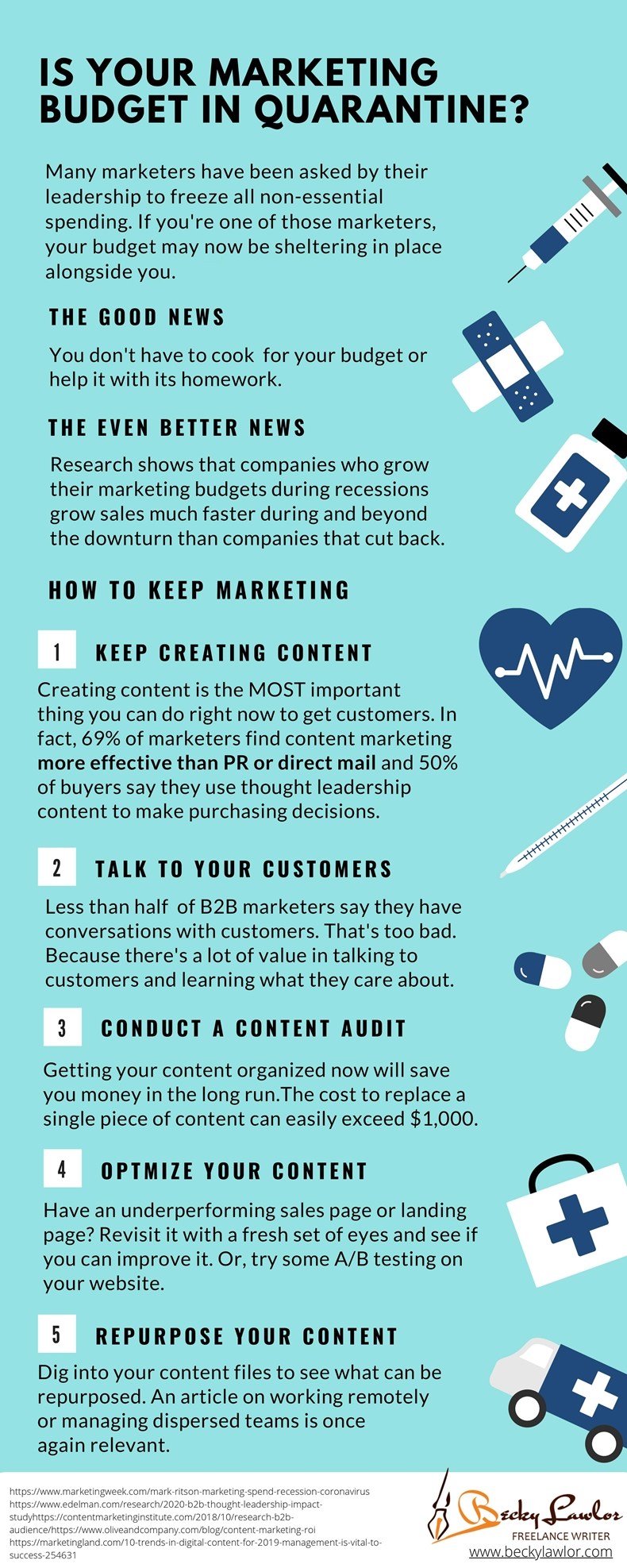The true nature of the economic fallout of the current coronavirus crisis is still far from certain, and many marketers have been asked by their leadership to freeze all nonessential spending. If you're one of those marketers, your budget may now be sheltering in place alongside you.
Here's the good news
You're not alone.
The global ad spend forecast is down from $712 billion to $691.7 billion because of the coronavirus pandemic's effect on media and commerce, according to EMarketer. Facebook and Google alone are facing a possible $44 billion decline in ad revenue in 2020.
Clearly, you're not the only marketer who is rethinking how and where to spend marketing dollars much more carefully now.
Here's the not-so-good news
Companies that increase their marketing budgets during a recession, or even a depression, increase sales much faster—both during and after the downturn—than companies that cut back, research shows.
But if your leadership isn't buying into the idea that spending on marketing is essential right now, you likely can't do much to change their mind. So how can you still continue to position your company to grow now and in the long term?
Here are five ideas that will cost you your time and energy, but not much else.
1. Keep your content marketing going
Creating content is probably the most important thing you can keep doing right now to help your business stay front and center in your customers' minds. It will continue building thought leadership and brand authority, and it has proven ROI:
- 69% of marketers say branded content to be more effective than both PR and direct mail
- 6x higher conversion rates for organizations that use content marketing compared with those that don't
- 7.8x higher year-over-year growth in unique site traffic for content marketing leaders, compared with followers
- Half of business decision-makers have used thought-leadership content as the deciding purchasing factor
The catch is that you can't just start pumping out any old content and expect a strong return on your investment—especially now, when people are overwhelmed by information about these "unprecedented times."
Your content has to be able to cut through the noise. That means it's got to be relevant, of exceptionally high quality, and engaging to your audience.
Don't take shortcuts.
2. Invest time in customer relationship-building
Less than half (42%) of B2B marketers say they have conversations with customers as part of their audience research, according to the MarketingProfs and Content Marketing Institute ( B2B Content Marketing Benchmark Report.
If you're one of the 58% of marketers who aren't talking with your customers—or even if you are—there's no time like the present to pick up the phone and get to know your customers even better.
Here are just a few of the things you might get out of your conversations:
- Insight into what motivates and interests your customers as individuals
- Feedback on your brands' products or services
- New opportunities for your brand to help your customers
- Intimate knowledge of industrywide challenges
- Deeper understanding of their biggest challenges and how those may have shifted because of COVID-19
Then, back to my first point about continuing to generate useful content: use all these customer insights from your conversations to develop content that reflects what you've learned.
Also, share your insights with relevant parties in the company. For instance, if your customer gave you some valuable product feedback, pass that information on to your product team.
3. Conduct a content audit
Most organizations have content spread all over, which means they're recreating the wheel instead of repurposing. And that's costly. Workers spend on average 20% of every day looking for lost files. And you can easily spend hundreds of dollars to replace a single piece of content.
Getting your content organized now will save you money in the long run and make it much easier to get more out of your investment in your content.
4. Optimize your content
If you haven't done any A/B-testing on your website, now would be the perfect time to give it a go. Try different headlines or different colors for your CTA buttons to see what happens.
Have an underperforming sales page or landing page? Revisit it with a fresh set of eyes and see where the copy might be falling flat and what you might do to improve it.
5. Repurpose older content
Now that you've conducted a content audit and know what content you have and where it is, you can also dig into your content files to see what can be repurposed. Maybe you've already got an article on working remotely or managing dispersed teams. Those topics are once again relevant, and with a few quick updates you can republish the content with a nod to the current situation.
Reap the rewards
Until your company feels healthy again, your budget may very well stay in quarantine, but that doesn't mean your marketing has to. Be creative and find ways to use this time to think strategically about how you can market now—and in the future.
And, most important, continue to stay the course in delivering thought-leading content that builds your brand authority and awareness. By doing so, you'll find that when you and your budget are no longer sheltering in place, your company is in a strong position to reap the rewards of those efforts.





